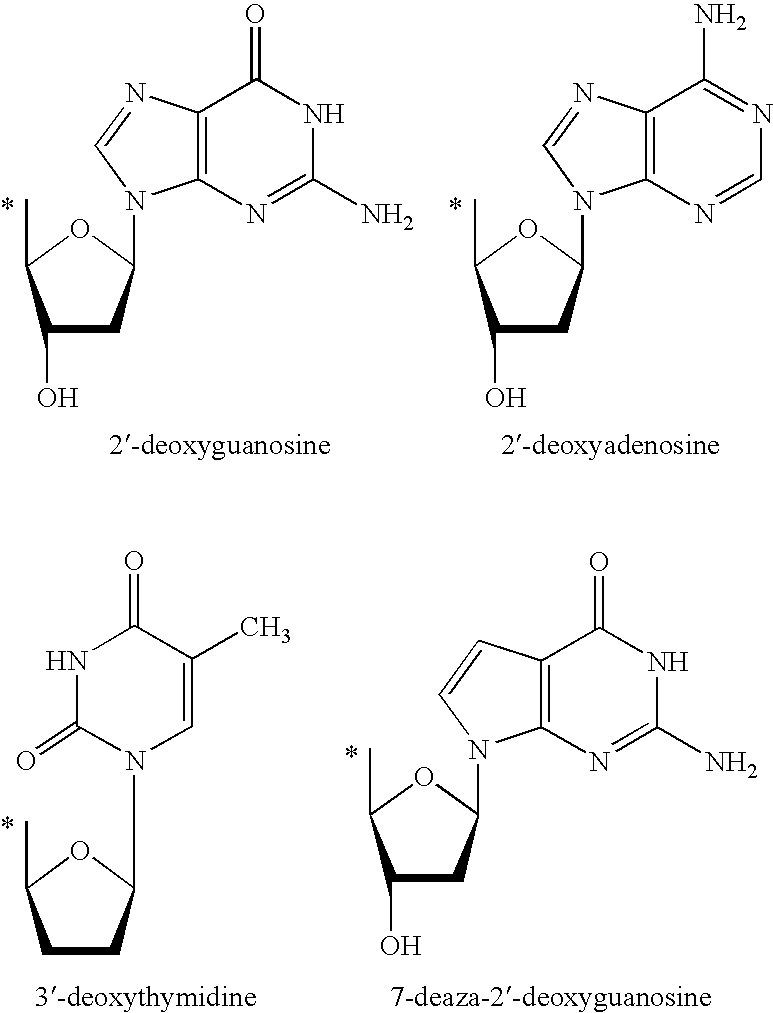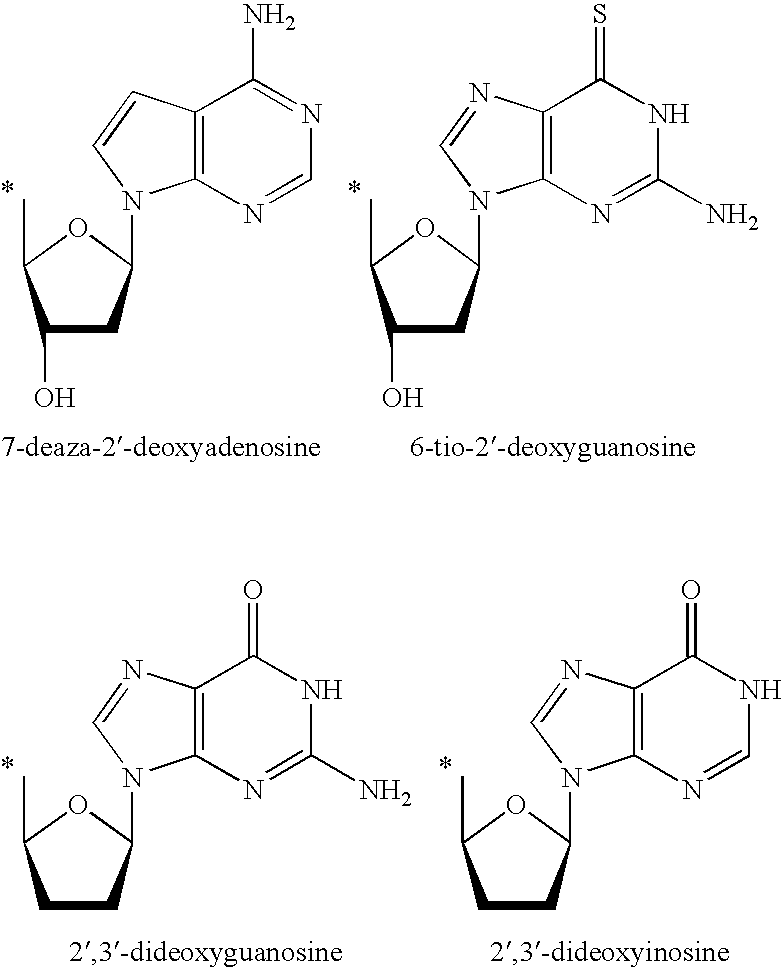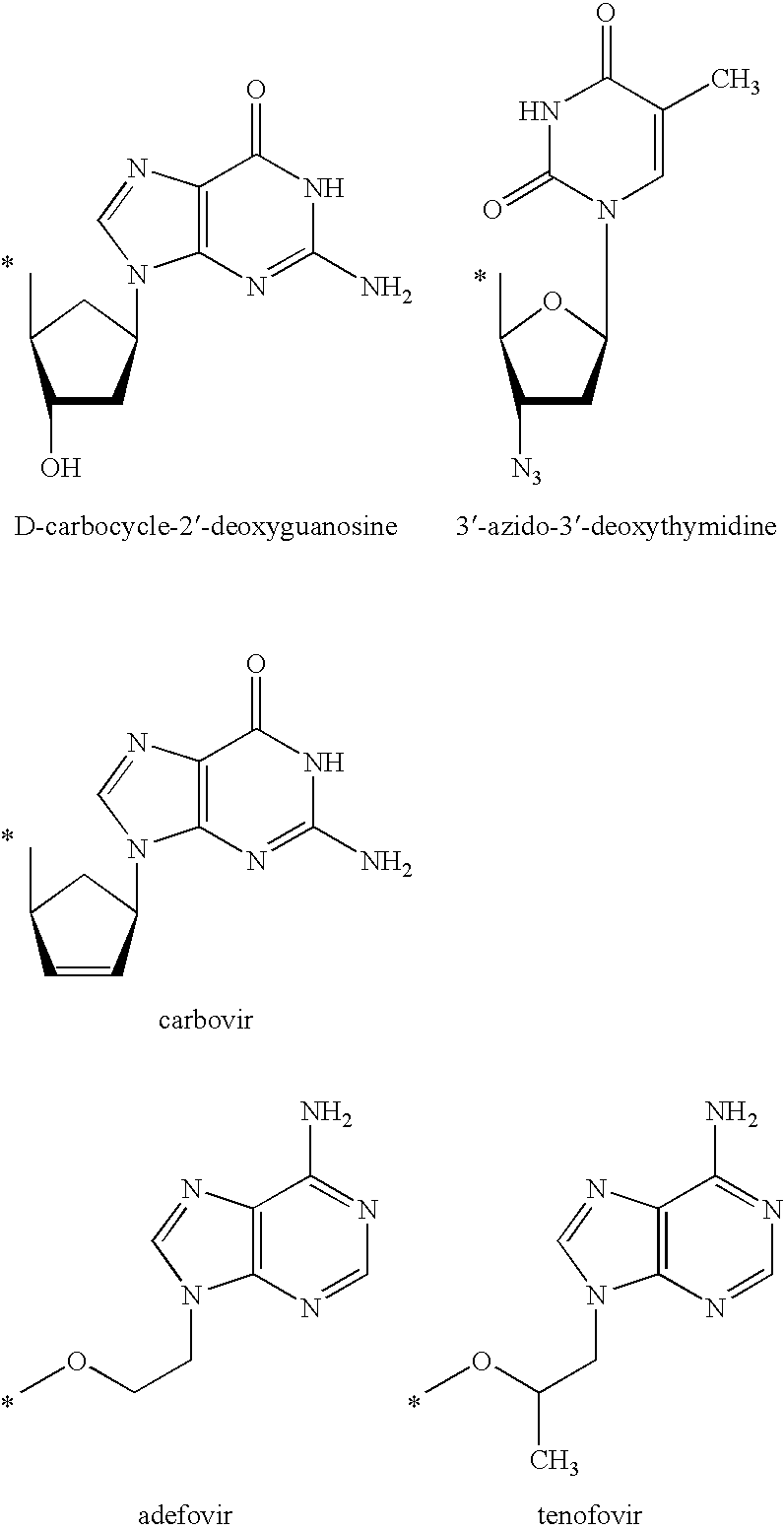Prodrugs Activated by Rna-Dependent Dna-Polymerases
a technology of rna-dependent dna polymerases and prodrugs, applied in the field of compounds, can solve the problems of high toxicity, limited effectiveness of therapeutic treatment of cancer and retrovirus-caused pathologies, and serious side effects of anti-aids drugs, and achieve the effect of increasing the effectiveness and tolerability of a cytotoxic compound
- Summary
- Abstract
- Description
- Claims
- Application Information
AI Technical Summary
Benefits of technology
Problems solved by technology
Method used
Image
Examples
example 1
[0038]Preparation of acyclovir monophosphate (ACVMP)
[0039]ACVMP was prepared using a procedure adapted from Yoshikawa et al. Tetrahedron Lett. 1967, 50, 5065. A mixture of 1 g acyclovir (4.3 mmol) and 6 ml triethylphosphate was gradually added to a mixture of 4 ml triethylphosphate and 860 μl phosphorus oxychloride (8.6 mmol) at 0° C. The mixture was maintained at 0-40° C. for 12 h under stirring. Then 100 ml of diethyl ether were added to precipitate the acyclovir-5′-phosphorodichloridate.
[0040]The precipitate was filtered and dissolved in 25 ml of ice-cold 5% NaHCO3 in water. After stirring at 0° C. for 1 h and at room temperature for 8 h, the pH was adjusted to 7.0 with NaOH 1M. After further 12 h under stirring, the mixture was evaporated to dryness, dissolved in the minimum volume of water and loaded onto a DEAE-cellulose column. The column was eluted with a linear gradient (0.05-0.8 M) of triethylammonium bicarbonate, pH 7.5. Appropriate fractions were evaporated under vacuum....
example 2
[0041]Preparation of acyclovir diphosphate (ACVDP)
[0042]ACVDP was synthesised using a procedure adapted from Hoard D. E. et al. J. Am. Chem. Soc. 1965, 87, 1785-1788. The tributylammonium orthophosphate, necessary for this transformation, was prepared as follows. Anhydrous orthophosphoric acid (5 g, 51 mmol) and 10 ml of CH2Cl2 were put in a Schlenk tube, under anhydrous condition. Tributylamine (12.25 ml, 51 mmol) was then added dropwise into the solution in 30 minutes. The mixture was left under stirring for 1 h. CH2Cl2 was evaporated and the reaction residue re-evaporated with 3×10 ml anhydrous pyridine and 2×10 ml of anhydrous DMF. The final product was dissolved in anhydrous DMF to a concentration of 1M, and stored over molecular sieves (4 Å) at 4° C.
[0043]ACVMP triethylammonium salt (1.01 g, 2 mmol) was converted into its pyridinium salt using Dowex 50W-X8 (pyridinium form resin). The column was eluted with 50% aqueous methanol. The eluted was evaporated under reduced pressure...
example 3
[0045]Preparation of Acycloguanosyl 2′-deoxy-5′-guanosyltriphosphate (ACVTPdG)
[0046]The tributylammonium salt of dGMP and ACVDP were prepared by first converting their sodium salt or triethylammonium salt in pyridinium salt by chromatography on a Dowex 50W-X8 column.
[0047]A solution of water (5 ml) and 700 mg dGMP (2 mmol) was loaded onto a Dowex 50W-X8 (pyridinium form). The column was eluted with 50% aqueous methanol. The eluent was evaporated under reduced pressure to dryness, and then 500 μl of tributylamine (2 mmol) and 10 ml water were added. After 30 minutes the mixture was evaporated to dryness. The resulting residue was subjected to 3×10 ml evaporation from anhydrous pyridine and 2×5ml evaporation from anhydrous DMF.
[0048]984 mg ACVDP triethylammonium salt (1.42 mmol) was dissolved in 5 ml water loaded on a Dowex 50W-X8 column and eluted with 50% aqueous methanol. The solution was concentrated under vacuum, and then 710 μl tributylamine (2.8 mmol) and 15 ml water were added...
PUM
| Property | Measurement | Unit |
|---|---|---|
| length | aaaaa | aaaaa |
| telomere length | aaaaa | aaaaa |
| critical length | aaaaa | aaaaa |
Abstract
Description
Claims
Application Information
 Login to View More
Login to View More - R&D
- Intellectual Property
- Life Sciences
- Materials
- Tech Scout
- Unparalleled Data Quality
- Higher Quality Content
- 60% Fewer Hallucinations
Browse by: Latest US Patents, China's latest patents, Technical Efficacy Thesaurus, Application Domain, Technology Topic, Popular Technical Reports.
© 2025 PatSnap. All rights reserved.Legal|Privacy policy|Modern Slavery Act Transparency Statement|Sitemap|About US| Contact US: help@patsnap.com



